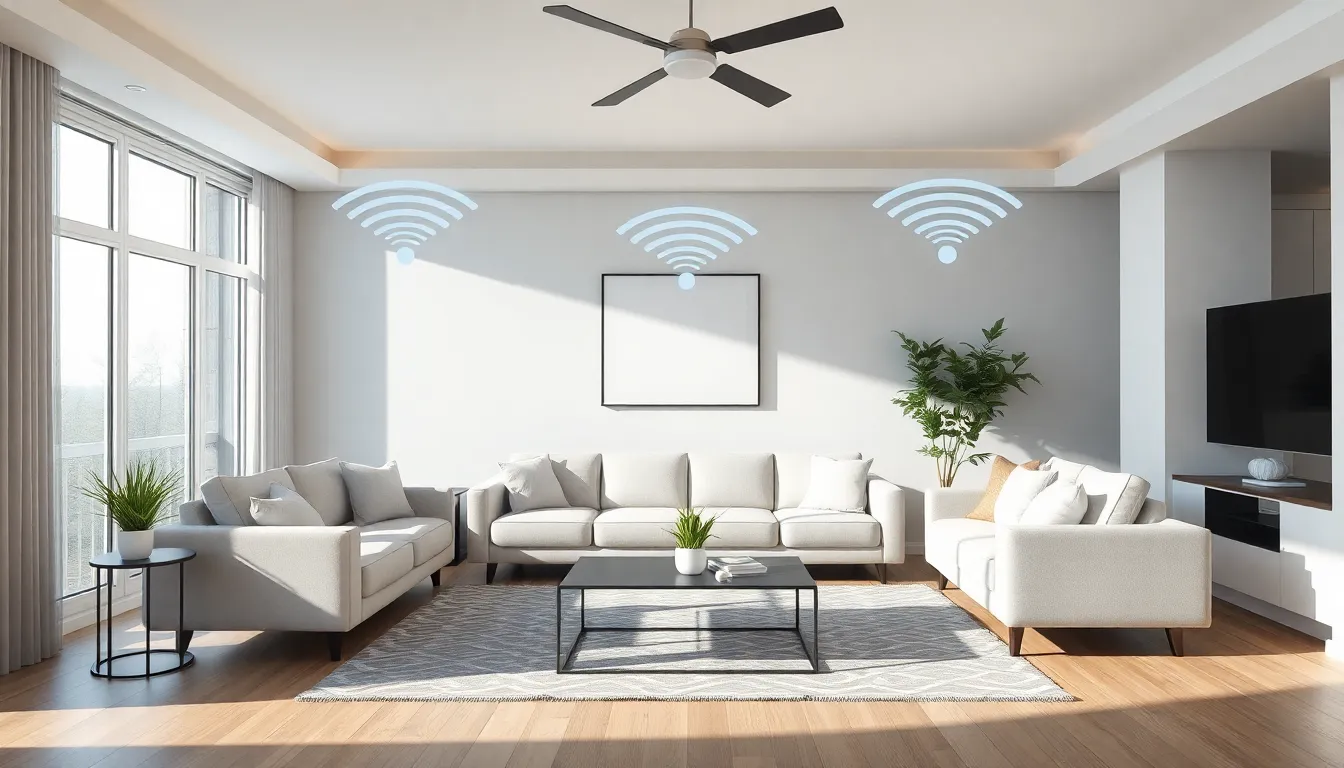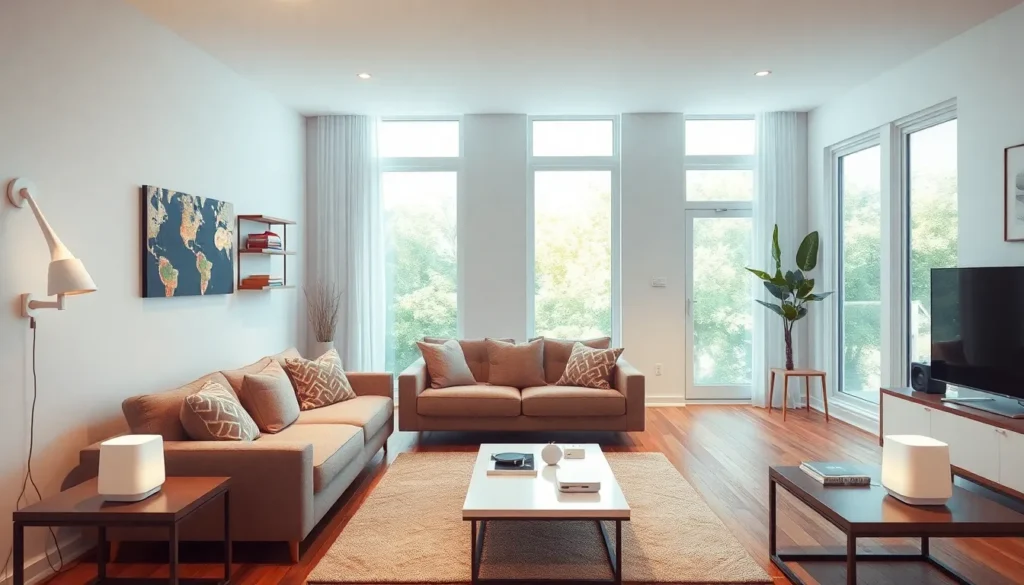In a world where buffering is the modern-day equivalent of waiting for a dial-up connection, a Google Mesh setup can be your knight in shining armor. It’s like upgrading from a bicycle to a Ferrari; suddenly, every corner of your home is a Wi-Fi wonderland. Gone are the days of dodging dead zones like they’re landmines.
Overview of Google Mesh Setup
Google Mesh setup offers a robust solution for enhancing home internet connectivity. This system replaces traditional routers, providing more consistent coverage across larger spaces. Mesh networks consist of multiple nodes working together to create a single, seamless Wi-Fi network.
Users place nodes in strategic locations throughout their homes. These nodes communicate with one another, ensuring strong signals reach every corner, eliminating dead zones. In spaces with several walls or multiple floors, this setup proves particularly beneficial.
Performance significantly improves with Google Mesh. Devices connect to the nearest node, resulting in faster speeds and reduced latency. Such efficiency allows for smooth streaming, gaming, and browsing across all devices simultaneously.
Installation remains straightforward. Users can follow the Google Home app for a guided setup process. This app helps in placing nodes optimally and managing network settings, making it user-friendly for all levels of tech-savvy individuals.
Security is another highlight. Google Mesh includes built-in security features that protect the network from unauthorized access. Users benefit from automatic updates, enhancing security over time without requiring manual intervention.
Cost varies based on the number of nodes required for adequate coverage. Typically, a system might include two or three nodes, with options for expansion as needed. This flexibility allows users to tailor their networks based on specific needs and home layouts.
Benefits of Google Mesh Setup

Google Mesh technology significantly enhances home Wi-Fi performance. Users experience superior connectivity and coverage, making it ideal for modern smart homes.
Enhanced Coverage
Strengthened Wi-Fi signals lead to extended coverage throughout the home. Multiple nodes work together to eliminate dead zones, ensuring consistent connectivity in every room. For homes with multiple floors or thick walls, placing additional nodes improves signal distribution. Many users report solid performance even in areas far from the primary node. The flexibility to position these nodes strategically allows for customization based on individual home layouts. As a result, families enjoy seamless internet access for devices in all corners of their living spaces.
Improved Connectivity
Devices connect to the nearest node, facilitating faster speeds and lower latency. This improvement makes streaming, gaming, and browsing more efficient. With automatic load balancing, Google Mesh intelligently manages traffic, optimizing performance even during peak usage times. Network congestion diminishes as more devices connect to different nodes. Frequent dropouts become rare due to the robust infrastructure provided by multiple nodes communicating effectively. Enhanced connectivity translates to a smoother online experience, meeting the demands of today’s digital lifestyles.
Step-by-Step Guide to Google Mesh Setup
Setting up a Google Mesh network is straightforward and user-friendly. This guide walks through the essential steps for achieving a seamless Wi-Fi experience.
Unboxing and Preparing Your Devices
Begin by unpacking your Google Mesh devices. Ensure the items include the mesh points and power adapters. Each device comes equipped with a quick start guide to assist with setup. Verify that all devices are free from damage before starting. Preparing your network environment is crucial; find a designated location for your primary unit, typically near your modem.
Connecting to Your Internet Source
Connect the primary mesh point to your modem using an Ethernet cable. This connection establishes the backbone of your mesh network. Plug the power adapter into the primary unit and into an electrical outlet. Wait for the device to power on completely. During this process, a solid light should indicate readiness. After this, the next step involves setting up additional mesh points for optimal coverage.
Configuring the Google Home App
Download the Google Home app from the App Store or Google Play. Create an account or sign in with an existing Google account to start configuring your mesh network. Follow the prompts in the app to add your new devices. The application will search for nearby mesh points. Once detected, tap to add them to your network setup. Ensure you customize your Wi-Fi network name and password according to personal preference for easy access.
Positioning Your Mesh Points
Strategically placing each mesh point ensures optimal coverage. Initially, start with the primary location near the modem and gradually add additional points throughout the home. Avoid heavy obstacles such as walls or furniture between nodes that may obstruct signals. Test the Wi-Fi connectivity as you position devices; each mesh point should be within a range of the primary unit. Aim to achieve a balanced spread of coverage, particularly in larger or multi-story homes.
Common Issues and Troubleshooting
Google Mesh users may encounter a few common issues during setup and use. Understanding these problems and their solutions can improve connectivity and overall user experience.
Connectivity Problems
Connectivity problems often arise in Google Mesh setups. Signals may weaken in certain areas due to physical obstructions like walls or appliances. To address this issue, users can reposition nodes to achieve optimal placement. Placing nodes on elevated surfaces enhances signal strength. Testing each node’s performance will help identify locations that require adjustments. In some cases, interference from other devices can disrupt the network. Changing the channel in the Google Home app can reduce this interference, leading to improved connectivity.
App Configuration Errors
Configuration errors within the Google Home app can hinder the setup process. Users might face challenges when customizing network settings or adding nodes. Double-checking Wi-Fi credentials for accuracy is crucial to resolving these issues. If the app fails to detect additional nodes, restarting the nodes and the app may help. Ensuring the Google Home app is up to date reduces the likelihood of encountering bugs or glitches. Restarting devices can provide a fresh start, enabling successful connections and configurations.
A Google Mesh setup revolutionizes home internet connectivity by providing seamless coverage and robust performance. Its user-friendly installation process makes it accessible for everyone looking to enhance their Wi-Fi experience. With strategically placed nodes, users can eliminate dead zones and enjoy high-speed internet throughout their homes.
The built-in security features and automatic updates ensure a safe and reliable network. As digital demands continue to grow, investing in a Google Mesh system is a smart choice for anyone wanting to improve their online experience. Embracing this technology not only enhances connectivity but also supports the modern smart home lifestyle.













